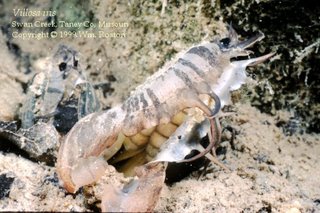As adults aren't going to move much, dispersal is down to the larval stages. Most freshwater mussels have a specialised larva called a glochidium that moves around by hitching a ride on a fish. But glochidia don't swim very well, so to increase the chances of the larvae getting a lift, the adult mussels lure fish closer ...
How does a bivalve entice a fish? The same way that a plant brings in a pollinator. It offers something the fish wants—either food or a mate. And this is where it gets weird.
Mussel shells look like mussel shells. They're stuck with that. But the mantle—the folds of tissue that surround the animal's body—can vary in colour and shape. Mussels can also flap the mantle to mimic the movements of another fish or wriggle it like a worm. What fish could resist? And when it comes closer, the glochidia latch on and hitch a ride.
 So how good is this mimicry? That was Lampsilis reevesiana looking so much like a small fish in trouble that the predators are heading in for a good feed. If you're not convinced, here's an animated gif. Videos are available here.
So how good is this mimicry? That was Lampsilis reevesiana looking so much like a small fish in trouble that the predators are heading in for a good feed. If you're not convinced, here's an animated gif. Videos are available here.
The rainbow shell Villosa iris resembles a crayfish right down to the movements. Check out the video.

And what do you think these are? Larval fish, right? Well, no. They're the egg sacs of the Ouachita kidneyshell Ptychobranchus occidentalis.

Look, I could show you pictures of these all night. But have a look for yourself at the Missouri State University's Unionidae site put together by Chris Barnhart.
Be amazed.